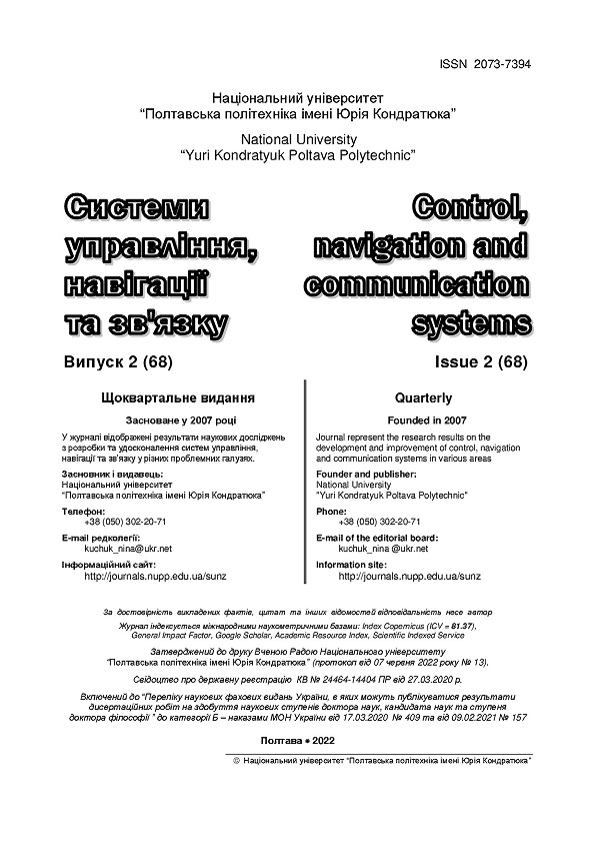MULTIPLICATIVE APPROXIMATION METHOD OF FUNCTIONAL DEPENDENCIES BY LINE SEGMENTS
DOI:
https://doi.org/10.26906/SUNZ.2022.2.037Keywords:
Linearization, Non-linear systems, approximation methods, multiplicative approximation methodAbstract
The article is devoted to the approximation problems of functional dependencies during conversions performed in intelligent measurement devices. Non-linearities are essential parts of most control processes and systems. When using a nonlinear transmitter with a conversion function in measurement information systems used in various fields, it is necessary to perform nonlinear functional conversion operations on numbers in microprocessors/microcontrollers during direct and indirect measurements. For this purpose, various approximation methods are used. The purpose of the approximation is to describe nonlinear functions in a simpler, more convenient way for utilization and calculations, with an insignificantly small loss of accuracy. Existent methods for linearization, although some of them are effective, can be burdensome for implementation in microprocessor-based systems. Here, one of the proposed methods for the approximation of nonlinear functional dependencies by line segments is proposed. In this method, the range of the argument changes in the function is divided into line segments, and the parts of the coordinate system bisector, remaining within the line segments of the function, is swapped to perform approximation. Having involved few simple mathematical operations, the proposed method can be implemented efficiently in microprocessors/microcontrollers to perform approximations in measurement systems.Downloads
References
Bertsimas, D.; Dunn, J.; Wang, Y. Near-optimal nonlinear regression trees. Oper. Res. Lett. 2021, 49, 201–2
Negrello, C.; Gosselet, P.; Rey, C. Nonlinearly Preconditioned FETI Solver for Substructured Formulations of Nonlinear Problems. Mathematics 2021, 9, 31
Petridis, K.; Drogalas, G.; Zografidou, E. Internal auditor selection using a TOPSIS/non-linear programming model. Ann. Oper. Res. 2021, 296, 513–5
Gajjar, H.K.; Adil, G.K. A piecewise linearization for retail shelf space allocation problem and a local search heuristic. Ann. Oper. Res. 2010, 179, 149–167.
Geißler, B.; Martin, A.; Morsi, A.; Schewe, L. Using piecewise linear functions for solving MINLPs. In Mixed Integer Nonlinear Programming; Lee, J., Leyffer, S., Eds.; Springer: New York, NY, USA, 2012; Volume 154, pp. 287–
Andrade-Pineda, J.L.; Canca, D.; Gonzalez-R, P.L. On modelling non-linear quantity discounts in a supplier selection problem by mixed linear integer optimization. Ann. Oper. Res. 2017, 258, 301–346.
Stefanello, F.; Buriol, L.S.; Hirsch, M.J.; Pardalos, P.M.; Querido, T.; Resende, M.G.C.; Ritt, M. On the minimization of traffic congestion in road networks with tolls. Ann. Oper. Res. 2017, 249, 119–139.
Sridhar, S.; Linderoth, J.; Luedtke, J. Locally ideal formulations for piecewise linear functions with indicator variables. Oper. Res.Lett. 2013, 41, 627–632.
Dulebenets, M.A. Advantages and disadvantages from enforcing emission restrictions within emission control areas. Marit. Bus. Rev. 2016, 1, 107–132
Pasha, J.; Dulebenets, M.A.; Kavoosi, M.; Abioye, O.F.; Theophilus, O.; Wang, H.; Kampmann, R.; Guo, W. Holistic tacticallevel planning in liner shipping: An exact optimization approach. J. Shipp. Trade 2020, 5,
Dulebenets, M.A. A comprehensive multi-objective optimization model for the vessel scheduling problem in liner shipping. Int. J. Prod. Econ. 2018, 196, 293–3
Meyer, R.R.A. Theoretical and computational comparison of ‘Equivalent’ mixed-integer formulations. Nav. Res. Logist. 1981, 28, 115–131.
Williams, H.P. Model Building in Mathematical Programming, 5th ed.; WILEY: Hoboken, NJ, USA, 2013. 13. Vielma, J.P.; Ahmed, S.; Nemhauser, G. A note on a superior representation method for piecewise linear functions. INFORMS J. Comput. 2010, 22, 493–497.
Imamoto, A.; Tang, B. Optimal piecewise linear approximation of convex functions. In Proceedings of the World Congress on Engineering and Computer Science, San Francisco, CA, USA, 22–24 October 2008; pp. 1191–1194.
Ahmadi, H.; Martí, J.R.; Moshref, A. Piecewise linear approximation of generators cost functions using max-affine functions. In Proceedings of the 2013 IEEE Power & Energy Society General Meeting, Vancouver, BC, Canada, 21–25 July 2013; pp. 1–5.
Vielma, J.P.; Ahmed, S.; Nemhauser, G. A note on a superior representation method for piecewise linear functions. INFORMS J. Comput. 2010, 22, 493–497.
Bisschop, J. AIMMS Optimization Modeling. 2021. Available online: https://documentation.aimms.com/aimms_modeling.html (accessed on 25 February 2021).
Guignard, M. Strong RLT1 bounds from decomposable Lagrangean relaxation for some quadratic 0–1 optimization problems with linear constraints. Ann. Oper. Res. 2020, 286, 173–2
Pauer, G.; Török, Á. Binary integer modeling of the traffic flow optimization problem, in the case of an autonomous transportation system. Oper. Res. Lett. 2021, 49, 136–1
Negrello, C.; Gosselet, P.; Rey, C. Nonlinearly Preconditioned TI Solver for Substructured Formulations of Nonlinear Problems. Mathematics 2021, 9, 3165




